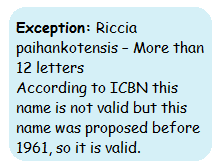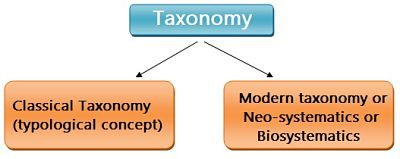Taxonomy and Nomenclature
Table of Content |
Taxonomy
 Taxis = orderly arrangement, nomos = law
Taxis = orderly arrangement, nomos = law
Taxonomy Definition: “Taxonomy is the study of principles and procedures of classification.”
Taxonomy includes study of following 4 points:
(1) Identification: Identification of living organisms
(2) Nomenclature: Nomenclature of living organisms
(3) Classification: Classification of living organisms in groups
(4) Affinities: Study of inter relationship between living organisms
Systematics (Branch Related with Taxonomy)
“Systematics is a branch of Biology that deal with cataloguing plants, animals and other organisms into categories that can be named, remembered, compared and studied.“
Study of only one organism of a group provides sufficient information about the remaining members of that group. Scientists connected with the study of systematics are called systematists or taxonomists.
Simpson, (1961) has defined systematics as the branch of biology that deals with the diversity of organisms at every level of classification.
Basics of Systematic Study
1. Characterization: The organism to be studied is described for all its morphological and other characteristics.
2. Identification: Based on the studied characteristics, the identification of organism is carried out to know whether it is similar to any of the known group or taxa.
3. Classification: The organism is now classified on the basis of its resemblance to different taxa. It is possible that the organism may not resemble any known taxa or groups. A new group or taxon is raised to accommodate it.
4. Nomenclature: After placing the organism in various taxa, its correct name is determined. If the organism is new to systematics, it is given a new name based on rules and conventions of nomenclature.
Differences between Classical Taxonomy and Modern Taxonomy
-
It deals with morpho species.
-
It has a typological concept.
-
Species is considered to be static.
-
It does not study evolution.
-
Interrelationship of species is alos not studied.
(b) Modern taxonomy
-
It is also known as Neo systematic or Biosystematics:
-
It has a population or biosystematics concept.
-
Species is considered to be dynamic.
-
It studies primitiveness, advancement and inter-relationships of species.
Nomenclature
1. Polynomial system:
According to this system name of any plant consists of many words.
For Example: Caryophyllum-Cqryophyllum saxatilis folis gramineus umbellatis corumbis.
2. Binomial system:
Binomial system was first proposed by Gaspard Bauhin in his book - "Pinax Theatre Botanica”.
Principle of Priority: The nomenclature is done by principle of priority. If two names are proposed for any plant after the 1753, the valid name is the earlier name proposed just after 1 May, 1753.
ICBN - "International Code of Botanical Nomenclature"
Main Rules of ICBN
1. According to binomial system name of any species consists of two names
(i) Generic name - Name of genus
(ii) Specific name - Trival name
Example: Specific Name: Mango; Generic Name: Mangifera indica
2. In plant nomenclature (ICBN), tautonyms are not valid i.e. generic name and specific name should not be same in plants. Example: Mangifera mangifera
But tautonyms are valid for animal nomenclature (ICZN-International Code of Zoological Nomenclature)
Example: Naja naja (Indian cobra), Raitus rattus (Rat)
 3. Length of generic mime or specific name should not be less than 3 letters and not more than 12 letters.
3. Length of generic mime or specific name should not be less than 3 letters and not more than 12 letters.
Example: Mangifera indica
4. First letter of generic name should be in capital letter and first letter of specific name should be in small letter. Example: Mangifera indica
But if specific name is based on the name of some person, its first letter should be in capital letter ego lsoetes Pantii
5. When written with free hand or typed, then generic name and specific name should be separately underlined. But during printing, name should be italized.
6. Name of scientist (who proposed nomenclature) should be written in short after the specific name Example: Mangifera indica Lin.
7. Name of scientist should be neither underlined nor written in italics, but written in roman, letters (simple alphabets)
8. If any scientist has proposed wrong name then his name should be written in bracket and the scientist who corrected the name should be written after the bracket.
Example: Tsuga canadensis (Lin.) Salisbury
Note: Linnaeus named this plant as Pinus canadensis
9. Scientific names should be derived from Latin or Greek languages because they are dead languages.
10. Type specimen (Herbarium Sheet) of newly discovered plant should be placed in herbarium (Dry garden).
11. Standard size of herbarium sheet is 11.5 × 16.5 inches
ICNB = International Code of Nomenclature 'for Bacteria
ICVN = International Code of Viral Nomenclature
ICNCP = International Code of Nomenclature for Cultivated Plants
3. Trinomial System:
Proposed by Huxley and Stricklandt. According to this system name of any plant or species is composed of three names
(ii) Specific name
(iii) Subspecifie name (Name of variety)
When members of any species have large variations then trinomial system is used. On the basis of dissimilarities this species is classified into subspecies
Example: Brassica oleracea var. botrytis (Cauliflower)
Brassica oleracea var. capitata (Cabbage)
Brassica oleracea var. caulorapa (Knol-Khol)


Question 1: Which of the following is a correct name -
(1) Solanum tuberosum
(2) Solanum Tuberosum
(3) Solanum tuberosum Linn
(4) All the above
Question 2: Taxonomy refers to –
(1) Plant classification
(2) Plant nomenclature
(3) Plant affinity
(4) All the above
Question 3: ICBN was first revised in –
(1) 1961
(2) 1964
(3) 1975
(4) 1753
Question 4: Systematics deals with –
(1) Classification
(2) Nomenclature
(3) Plant description


| Q.1 | Q.2 | Q.3 | Q.4 |
| 3 | 4 | 3 | 3 |
Related Resources
-
You may wish to refer Taxonomical Aids
- Refer Past Year Question Papers of NEET (AIPMT)
-
Read here about Biological Classification
- Click here to refer the Useful Books of Biology for NEET (AIPMT)
To read more, Buy study materials of The Living World comprising study notes, revision notes, video lectures, previous year solved questions etc. Also browse for more study materials on Biology here.
View courses by askIITians


Design classes One-on-One in your own way with Top IITians/Medical Professionals
Click Here Know More

Complete Self Study Package designed by Industry Leading Experts
Click Here Know More

Live 1-1 coding classes to unleash the Creator in your Child
Click Here Know More




